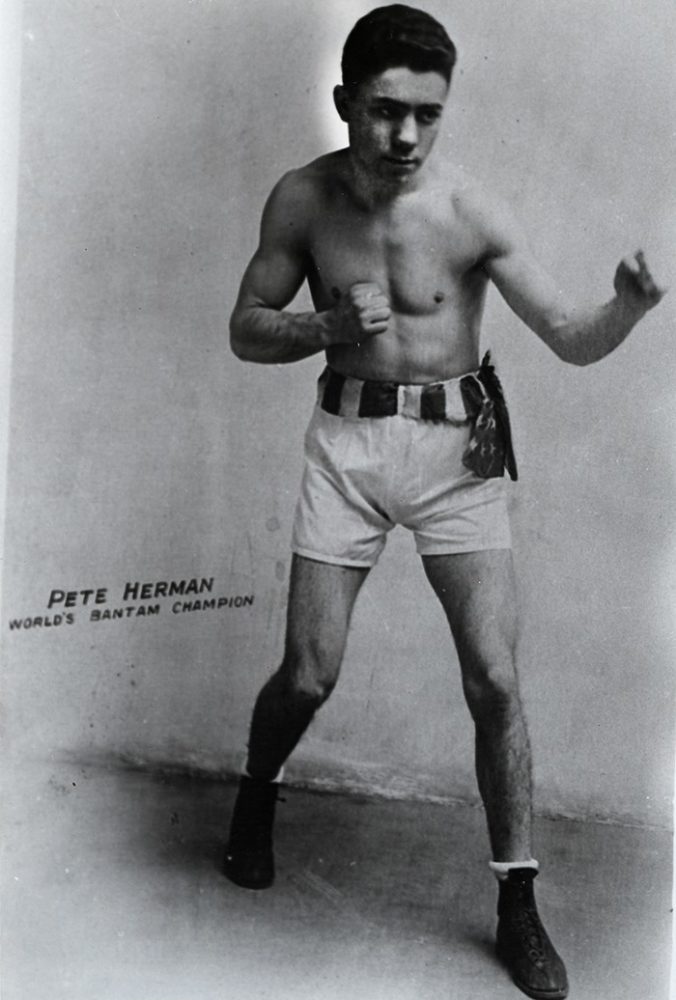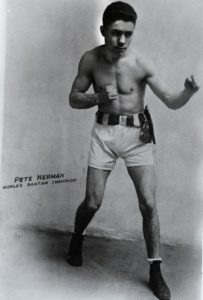Pete Herman
Pete Herman, world champion bantamweight boxer, owned and operated a popular French Quarter bar until his death in 1973.

Courtesy of The Historic New Orleans Collection
Pete Herman, World's Bantam Champion. Unidentified
Built more like a jockey than a boxer, Pete Herman was a world-champion bantamweight boxer. He battled poor eyesight during his eleven-year professional career, eventually leaving the ring when he became totally blind. Herman later owned a popular nightclub bearing his name in the French Quarter of New Orleans.
Herman was born Peter Gulotta on February 12, 1896, in Convent, to itinerant Italian parents who traveled throughout South Louisiana. As a young man he spent a good deal of time in the French Quarter, where he worked as a bellhop and as a shoeshine boy in a barber shop. There he learned about boxing from old copies of the Police Gazette. The stories he read about a popular lightweight prizefighter named Kid Herman sparked his interest in boxing and inspired his nom de guerre: Pete Herman.
Measuring five feet two inches tall, the diminutive Herman might have been more suited for jockey silks, but the scrappy young boxer made his professional debut on September 30, 1912, in a six-round draw against Eddie Coulon at the Orleans Athletic Club. Herman battled his way through the ranks of local and regional bantamweights (115 to 118 pounds) until he was matched against Kid Williams on June 30, 1914, at Pelican Stadium. He would eventually win the world bantamweight title in his third meeting with Williams on January 9, 1917, at the Louisiana Auditorium in New Orleans in a controversial twenty-round decision.
Between 1912 and his retirement in 1922, Herman compiled a record of seventy-one victories, twelve losses, and eight draws. He also fought in fifty-seven fights declared no-decision—bouts held where boxing was deemed illegal did not go on the record. Although he fought frequently, the majority of these fights were not in defense of his title.
He lost the title to Joe Lynch on December 22, 1920, at Madison Square Garden in New York City, and then became the first bantamweight champion to regain his title, defeating Lynch before a crowd of 20,000 at Ebbets Field in Brooklyn, New York, on July 25, 1921. In addition to losing the title to Johnny Buff two months later at Madison Square Garden, he was also losing his eyesight.
Herman’s vision had first been jeopardized during an exhibition match in Philadelphia, Pennsylvania, to benefit World War I servicemen. According to Herman, Gussy Lewis “thumbed” his eye, leaving him partially blind. Additional stints as a navy fight instructor during the war also took a toll on his eyesight, as he would fight between ten and fifteen men a day. He hid his blindness from Sam Goldman, his manager, as well as from the physicians who examined him before and after each fight. In those days the doctor would do little more than check the boxer’s pulse and blood pressure, and examine any bleeding cuts.
In his final fight, against Roy Moore on April 24, 1922, in Boston, Massachusetts, Herman lost his sight completely in the fourth round. But he continued the match by talking to his opponent, drawing him closer and then delivering such fierce punches at close range that the referee nearly stopped the fight. Although he had often been unable to see at the end of fights in the past, this time his eyesight would not return.
Herman owned and operated his popular French Quarter bar until his death on April 13, 1973, at the age of seventy-seven. He was inducted into the Louisiana Sports Hall of Fame in 1960 and the International Boxing Hall of Fame in 1997.
